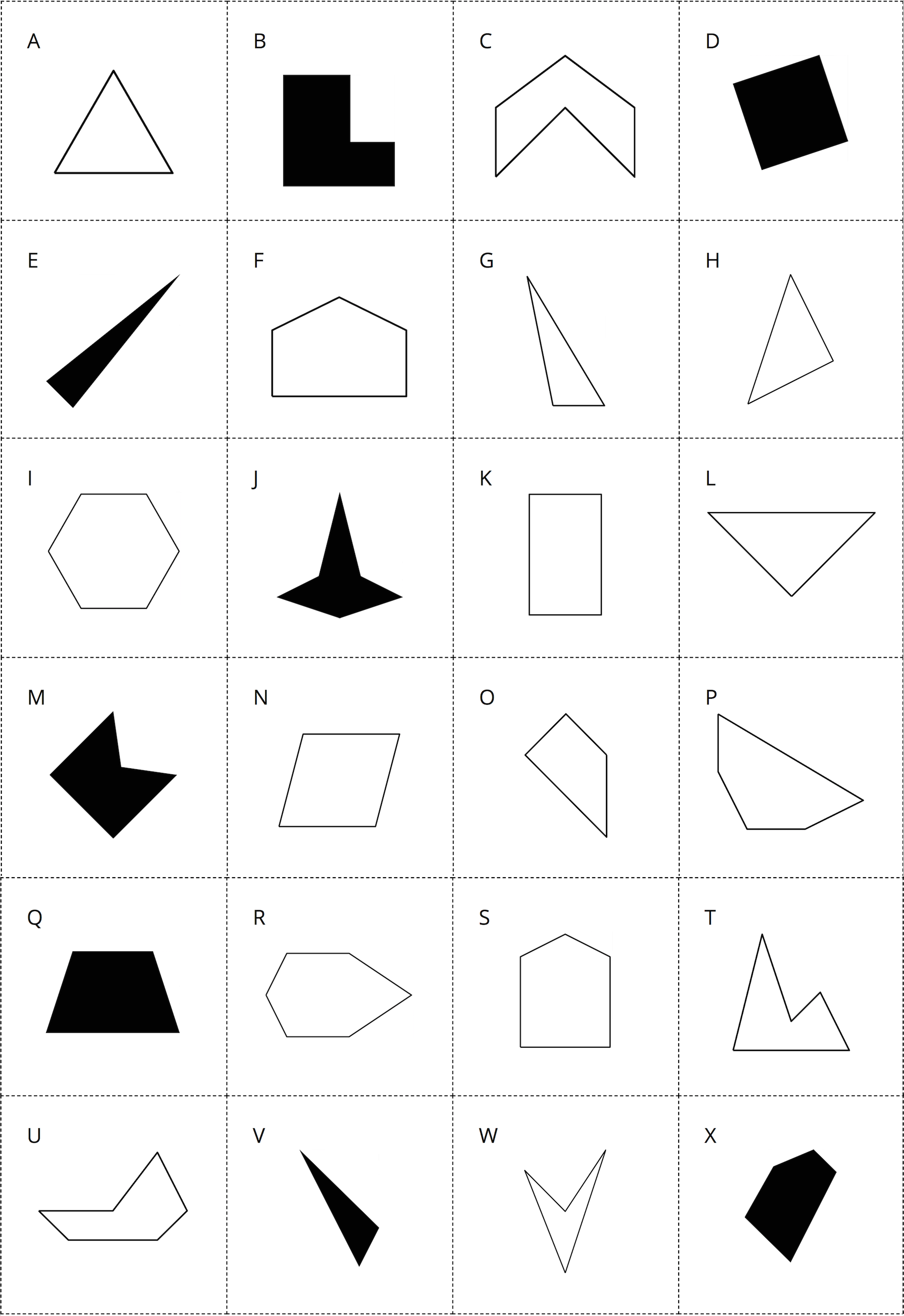Lesson 1
What Attributes Do You See?
Warm-up: Which One Doesn’t Belong: Who’s in the Group? (10 minutes)
Narrative
Launch
- Groups of 2
- Display the image.
- “Pick one that doesn’t belong. Be ready to share why it doesn’t belong.”
- 1 minute: quiet think time
Activity
- “Discuss your thinking with your partner.”
- 2–3 minutes: partner discussion
- Share and record responses.
Student Facing
Which one doesn’t belong?




Student Response
For access, consult one of our IM Certified Partners.
Activity Synthesis
- “Let’s find at least one reason why each one doesn’t belong.”
Activity 1: Card Sort: Shapes (35 minutes)
Narrative
The purpose of this activity is to encourage students to observe attributes of shapes and use them to sort shapes into groups. When students sort the cards, they look for common attributes or structures shared by different shapes (MP7). Students notice that there are multiple ways to categorize the shapes and that a shape may belong to more than one category depending on the attributes used to sort.
In grade 2, students refer to right angles as square corners. Here, students learn to use the terms angle in a shape and right angle in a shape to describe the corners of shapes. Note that the term “angle” here is understood informally and used only in reference to shapes and their geometric attributes (for instance, to distinguish rhombuses from squares). Students will not learn the formal definition of an angle—a figure formed by two rays that share an endpoint—or that it is a measurable attribute until grade 4.
When students consider the language they use and revise it to describe a shape in detail or with more specificity, they attend to precision (MP6).
The cards in this activity will be used again in centers.
Advances: Conversing, Reading
Supports accessibility for: Memory
Required Materials
Materials to Copy
- Shape Cards Grade 3
Required Preparation
- Create a set of cards from the blackline master for each group of 2.
Launch
- Groups of 2
- Distribute one set of pre-cut cards to each group of students.
- “What kinds of words do we use to describe shapes?” (sides, corners, flat, curved, diagonal)
Activity
- “In this activity, you will sort some cards into categories in a way that makes sense to you. Work with your partner to come up with categories and then sort the shapes.”
- 8 minutes: partner work time
- Pause for a discussion. Invite groups to share their sorted shapes without naming the categories.
- As each group shares, ask the class to guess the categories and whether others have sorted the same way.
- Record and display the attributes each group used to categorize the shapes (for example: number of sides, length of sides, shading, types of corners).
- “Now, you’ll take turns sorting your shapes in a secret way and see if your partner can guess how you sorted your shapes into categories.”
- 10 minutes: partner work time
Student Facing
Your teacher will give you a set of cards that show shapes.
- Work with your partner to sort the cards into categories. Be prepared to explain your categories.
- Take turns sorting the cards into two new categories. Don’t tell your partner how you sorted them. Your partner will then guess how you sorted your shapes.

Student Response
For access, consult one of our IM Certified Partners.
Activity Synthesis
- Invite groups to share any new categories that came up during their partner work time. Record any additional attributes used to sort the shapes.
- “What words or phrases were helpful for describing the shapes?” (four, five, side, corner, length, equal, triangle, square, rectangle, pentagon, hexagon)
- Display card O.
- “The part of the shape where two sides meet is called an angle in the shape. How many angles does this shape have?” (Shape O has 4 angles.)
- “This shape also has two special angles. Their sides join in a way that forms a right angle in the shape. This is the way the sides join in a square and in rectangles. What other shapes have right angles?” (B, F, M, and S)
Lesson Synthesis
Lesson Synthesis
“Today we sorted shapes into categories based on their attributes. We saw that a shape could belong in different categories depending on which attribute we use.”
Display cards A and S from the first activity.
“Suppose a student puts A and S in the same category. Which attribute might they have used to sort shapes?” (Length of the sides: A and S have sides with equal length. Size of corners or angles: Both shapes have corners that are the same size. Shading: Neither shape is shaded.)
“Suppose another student puts A and S in different categories. Which attribute might have they used to sort the shapes?” (Right angles: A has none and S has two. Equal sides: All sides of A are equal, but not all sides of S are. Number of sides: A has three, S has five.)
Cool-down: Tell Me About It (5 minutes)
Cool-Down
For access, consult one of our IM Certified Partners.